New Mars Forums
You are not logged in.
- Topics: Active | Unanswered
Announcement
#26 Re: Science, Technology, and Astronomy » Thermodynamics Study with Gemini >> Gas in Cold Pipe » 2025-08-28 12:57:10
Using a light gas gun to accelerate payloads to Earth escape velocity is an innovative approach. Barrel wear would be a problem at such speeds. I wonder if the barrel can be lined with a sacrificial shell that is discarded after each shot?
#27 Re: Science, Technology, and Astronomy » Thermodynamics Study with Gemini >> Gas in Cold Pipe » 2025-08-28 10:44:01
Gas temperature is nearly 60,000K. The gas will be ionised plasma at this temperature. That is a direct result of shock heating. Your tube temperature reaches 9000K in <1s. I don't see how this could work as a method for gathering propellant from the atmosphere.
One thing I find interesting. The specific heat of air between 100K and 60,000K, averages at 1KJ/kg.K. Roughly what it is under standard conditions.
#28 Re: Meta New Mars » Calliban Postings including links to notable contributions » 2025-08-28 10:37:59
It might work better for a lower stage, which would presumably have a lower peak velocity. At 2km/s, the incoming air will carry some 2MJ/kg of kinetic energy. That much heating is more manageable via regenerative cooling and is beneath dissociation temperatures, which start to become significant at temperature >2500°C. Boosting an upper stage to say 2km/s at 30km seperation height would greatly improve payload capacity.
#29 Re: Not So Free Chat » Peter Zeihan again: and also other thinkers: » 2025-08-28 09:37:14
Void, the woman that runs the Promethean updates is a conspiracy nut. The British empire was disbanded from 1947 onwards and is now no more than a smattering of islands and marginal territories in addition to the British Isles themselves. The people running the UK are halfwits, whose arrogance is outweighed only by their incompetance. They cannot even run a mid-sized domestic economy successfully and are powerless in preventing their country from being invaded by unarmed Islamic men. Yet, we are to believe that these obviously limited people are in fact running a shadowy underground empire and are secretly controlling the world? The idea is laughable to anyone that knows them. If that really were their intent, then they have made a really crappy job of it.
#30 Re: Science, Technology, and Astronomy » Thermodynamics Study with Gemini >> Gas in Cold Pipe » 2025-08-28 09:26:07
TH, at that speed (>Mach 30) the air would be shock heated into a plasma as it enters the tube. W.r.t to the tube, the air is moving at 11km/s. That is a kinetic energy of 60.5MJ/kg, all of which is converted into a combination of pressure and thermal energy, as the air accelerates to the velocity of the tube. Your tube will probably melt and frontal pressure will blow it apart. Did Gemini pick that up?
#31 Re: Meta New Mars » Calliban Postings including links to notable contributions » 2025-08-28 09:03:56
TH, yes indeed. Wood is a low embodied energy material that is often recycled. In my case, the wood that I used to make the machine would otherwise have been cut into firewood. When the machine reaches the end of its life, the wood will fulfill that purpose once again. The same can probably be said of the various machines listed in the book.
I used other materials in my machine. Screws, bearings, steel strap, epoxy glue, oil based paint, polymer rope and aluminium for the blades. Still, I estimate that wood is 90% of total mass. My device cost me around $300 in parts and a good deal of time. Still, that is free time that I otherwise would have wasted watching reruns of old scifi.
Could I have reduced the the input of non-wood materials with additional effort? Yes. It would have taken more time and carefull design.
I estimate that the mill will raise about 2000kWh of mechanical work each year. Over a 15 year life, that amounts to 30,000kWh, or $0.01/kWh. Much cheaper than the $0.3/kWh that is the insane cost of electricity in the UK. If I put a price on my time, then the savings would be lower. But everyone needs a hobby. A hobby that makes or saves money is always a good thing.
#32 Re: Home improvements » Misc. Home Projects » 2025-08-27 10:19:47
The rotor is now installed!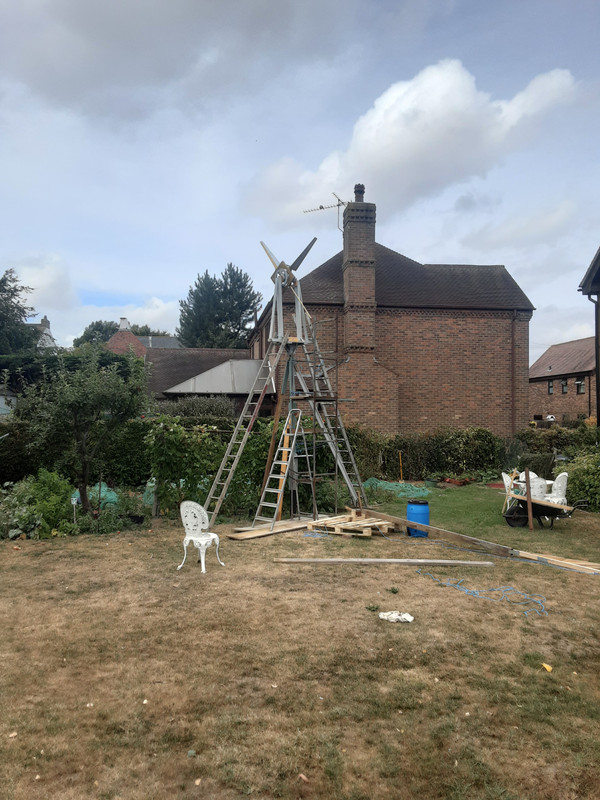
I still have some work to do to get the machine running. Weather permitting, it will be up and running by weekend. This has been the toughest DIY project I have ever taken on. I renovated a house with less time and effort than it took to build this. In heinsight, I would do it differently.
This book containsdesign information for a number of different windmills built by settlers in north America in the 19th century.
https://core.ac.uk/download/17270953.pdf
Most of these would have been less efficient than my mill, but easier to build. Ease of construction is an important factor when choosing a windmill design. My mill was a pig to build and assemble.
#33 Re: Meta New Mars » Calliban Postings including links to notable contributions » 2025-08-26 02:15:28
My plan was to mount the lower pulley and clutch on long bolts, which would be tightened to adjust the tension. However, an idler pulley may work better, as it would allow the clutch to remain at constant height. This woukd make interface with tools much easier. I may modify the design to include an idler wheel.
#34 Re: Home improvements » Misc. Home Projects » 2025-08-25 13:23:32
It has been bank holiday weekend here in the UK. I have spent 3 days working on my windmill. After months of work the end is now in sight. Today I have hoisted the rotor.
This picture shows the rotor on the ground prior to hoisting onto the tower.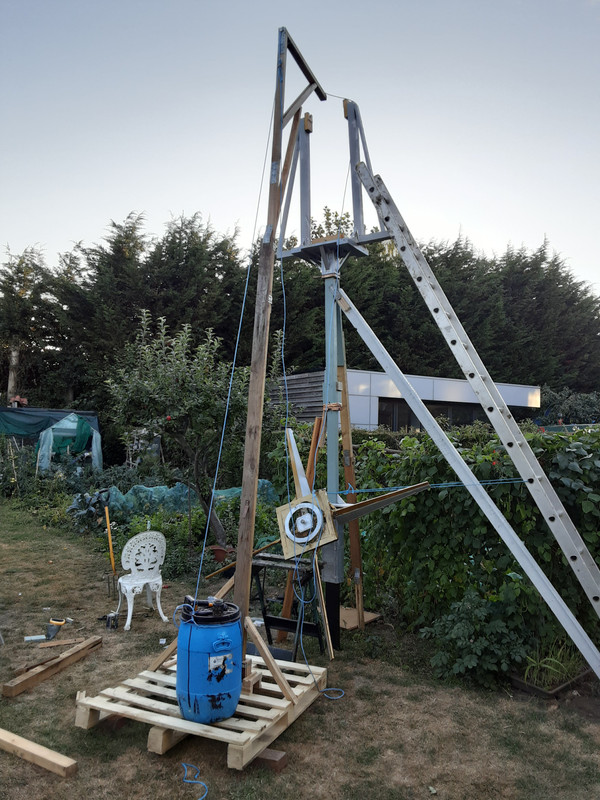
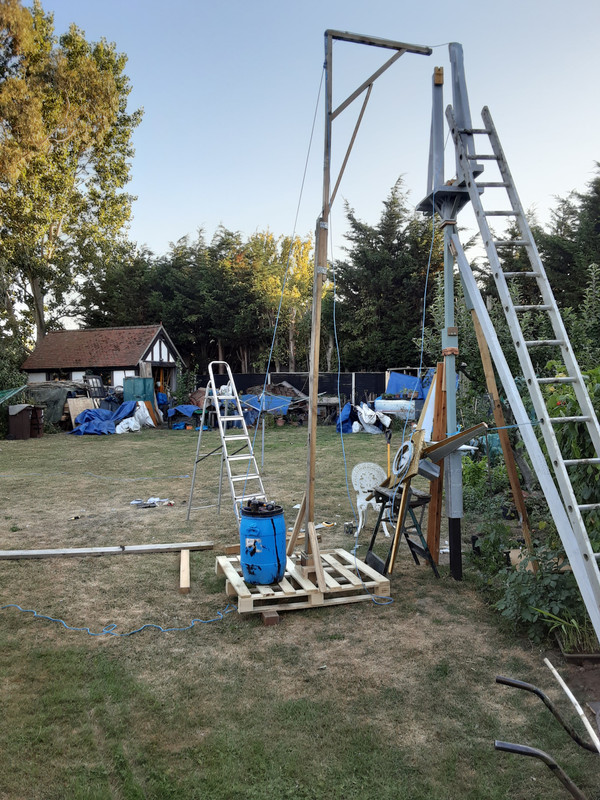
I decided to add a scaffold tower for extra stability. At the end of today, the rotor is hoisted onto the table at top of the tower.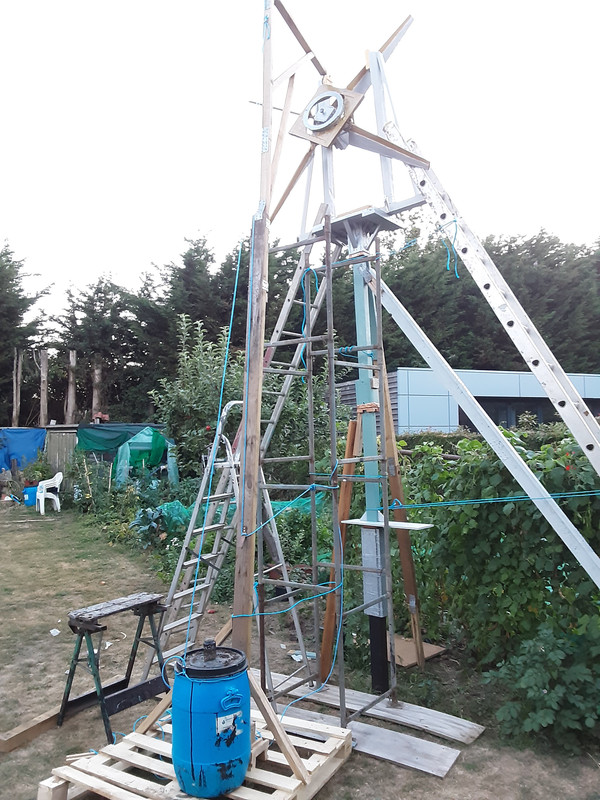
Tomorrow after work, I will be adding a platform to the scaffold tower and lifting the rotor bearings into their cradles. At this point, work on the rotor will be complete. All that will remain is to attach the rope drive.
#35 Re: Not So Free Chat » Oil, Peak Oil, etc. » 2025-08-24 03:17:57
The Chinese solar industry is crashing.
https://youtu.be/tRFWEy8O4rU
Prior to the Trump tarrifs, the industry was functioning as a pyramid scheme, with close to zero profit margins. It was reliant on future growth to stay ahead of debt repayment. But the problems with integrating solar into a grid system put a ceiling on how much solar power other countries could buy, limiting its rate of growth. Tarrifs have added to the problem.
#36 Re: Science, Technology, and Astronomy » Earth Geosynchronous Orbit » 2025-08-22 16:57:30
GEO is getting increasingly crowded. Given the need to maintain distance between satellites, we may reach a point where there is no more room for new satellites without removing old ones. This may ultimately be solved by installing an orbital ring at GEO. Satellites can be bolted to this ring without need for station keeping or seperation from other satellites. A ring would greatly increase the capacity of GEO.
#37 Re: Not So Free Chat » Oil, Peak Oil, etc. » 2025-08-21 04:34:44
Regarding energy payback time for solar PV. This metric depends heavily on where a PV powerplant is built. It is difficult to find much information that isn't behind a paywall. But this site gives some valuable information that we can use to make estimates.
https://greenchemuoft.wordpress.com/201 … lar-cells/
About 1.5kg of silicon are needed per m2 of panel. This gives an overall embodied energy of 1500kWh/m2 of collector. Solar panel efficiency varies, but crystaline silicon PV is genedally assumed to have efficiency 25% BOL, falling by 0.8% per year. Say an average of 23% in the first five years of life. Energy payback time then depends heavily on local insolation.
In the UK, annual insolation varies between 1100kWh/m2 in Devon and Cornwall, to a low of 700kWh/m2 in north west Scotland. At the high end, energy payback time would be 5.93 years. At the low end, 9.32 years. In Spain, insolation may be as high as 2000kWh/m2/year. In this case, EPBT will be 3.26 years. Some parts of the US south west can receive as much as 2400kWh/m2/year. In the case EPBT will drop to 2.7 years.
The EPBT does not account for any energy invested in inverters, transmission or storage. These ranges of EPBT are therefore only accurate if we are using power as DC, close to the source and without storage. It also doesn't include the costs of maintenance. Accepting these limitations, and assuming a 25 year service life, EROI for the basic powerplant range from a low of 2.68 in NE Scotland to a high of 9.2 in the US SW. In the case of NE Scotland, it is debatable whether the plant would even break even when the energy costs of transmission, inverters, frequency control and backup power are included. In the US SW, such additions would still leave EROI comfortably in single digits, but this is still low compared to practically any other competing energy source.
One thing to keep in mind is that much of the energy input to PV manufacture is fuel energy. But the energy output is in the form of electricity. This does improve the energy economics of PV, because if we had simply burnt that fuel to generate electric power, something like 50-70% of it would have been lost as waste heat. Some EROI analyses do account for this. But it is worth noting that it is also true for every other energy source to a varying extent. The energy needed to make the steel and concrete inputs to a nuclear powerplant, for example, are a mixture of coal, natural gas and electricity. The energy output from the plant is electricity and low grade heat, which could potentially be used but usually isn't.
#38 Re: Not So Free Chat » Oil, Peak Oil, etc. » 2025-08-20 14:01:01
One way of avoiding the problem of electrode attack would be to use high pressure argon as the electrode material. At a sufficiently high voltage gradient, argon becomes electrically conductive. Metallic electrodes would sit about one inch above the magma surface. The magma itself is electrically conductive when molten, due to the presence of ionic compounds within it. So the argon allows electric current to flow from the electrodes into the magma. Something like this: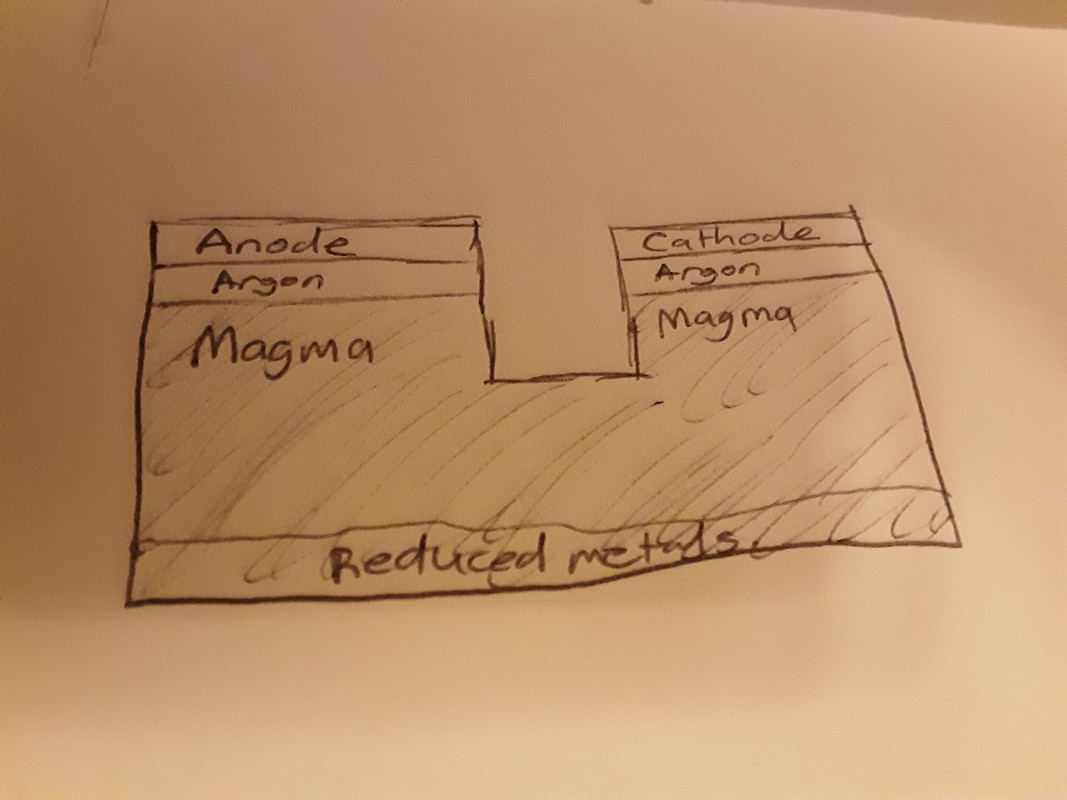
The argon acting as the anode would need to be constantly purged with fresh argon as oxygen would build up in the gas.
One complication with this approach is the potential solubility of argon into the magma melt. Whether this would be an intractible problem, I do not know.
#39 Re: Not So Free Chat » Oil, Peak Oil, etc. » 2025-08-20 11:19:59
Void, that is impressive. The Blue Origin process is a form of magma electrolysis, not too different to how aluminium is produced here on Earth. Aluminium production requires graphite electrodes, which are rapidly consumed as the carbon reacts with oxygen ions produced by electrolysis. I wonder what the Blue Origin electrodes will be made from?
******
Additional 1: I wonder if a flux material with a lower melting point than iron is a possible addition to magma electrolysis? If so, reduced iron or iron silicon electrodes could be used in the electrolysis cell. These would be consumed as they are attacked by oxygen ions. However, reduced iron and silicon will be the most abundant materials emerging from the electrolysis and all iron that dissolves into the magma will ultimately be recovered.
Sodium oxide could be one such material.
https://en.m.wikipedia.org/wiki/Sodium_oxide
Its melting point is 1132°C. Sodium is also one of the most reactive metals on the periodic table. Sodium oxide would therefore remain in the magma until all other components are reduced. If new regolith is continuously introduced, the sodium oxide would remain as a stable flux within the magma.
Additional 2: Come to think of it, reduced iron has a specific gravity of 7.8. It will therefore be much denser than the other materials in the electrolysis cell and will fall to the bottom. An iron electrode at the bottom of the cell would therefore be covered in a mixture of iron and silicon, protecting it from attack.
#40 Re: Not So Free Chat » Oil, Peak Oil, etc. » 2025-08-20 03:37:20
Kbd512, that is a good analysis. Polysilicon production consumes a lot of coal already. According to your reference, carbon is needed to reduce the silicon dioxide into metallurgical silicon, and hydrogen is needed to make the silane for purification into semiconductor grade. These processes are very difficult to divorce from fossil fuel inputs, unless we source the carbon and hydrogen from biomass. This means that attempting to substitute PV for other energy sources will only serve to shift fossil fuel consumption from electricity production into PV manufacturing. The alternative (biomass) places another unsustainable burden on the Earth's forests.
In areas with plenty of direct sunlight, trough solar thermal collectors can be used to raise steam at 300°C. This is beneath superheat temperatures, but it should be possible to generate power with 30% efficiency. When heat losses from the collectors is factored in, it turns out that a solar thermal powerplant has about the same power density as a PV plant. So the obvious question is why are we trying to generate power using slabs of semiconductor grade silicon instead of simple, curved alloy steel reflectors? The embodied energy in a curved steel mirror is at least an order of magnitude lower than a PV panel. And the technology is really simple. Mirrors, coolant pipes, boilers and steam generator sets. This is close to Victorian levels of technological sophistication. We can add energy storage using stainless steel tanks containing molten nitrate salts. We could even co-fire solar thermal plants with biomass or coal. This means that long duration backup power doesn't need a whole other power station. Just a seperate boiler, but using the same steam generator set.
I can see areas where PV is useful. In offgrid small power situations, you want an energy source that requires no attention once installed, uses no fuel and has no moving parts. In those small power situations, cost and embodied energy are less important because the systems involved are generating only small amounts of energy for important functions. You wouldn't build a solar thermal plant to power a wrist watch, a traffic light or a calculator. But given the resource requirements, building a PV plant to power a city looks like the wrong technology choice as well. All technologies have their specific niches where they make sense. For some reason, the people in charge have lost sight of that. They are making decisions based upon what is trendy.
#41 Re: Terraformation » Plutoids and Rogue Planets, Titanformation process, a cold treasure? » 2025-08-20 02:52:24
Oxygen depletion systems have been around for a while. They are usualy used as fire preventative measures and have been popular in libraries storing important texts. They work by reducing the partial pressure of oxygen in a space and replacing it with additional nitrogen. A reduction in oxygen partial pressure from 210 to 150-180mbar, doesn't sound like much. But it makes fire ignition less likely and impedes fire growth if one does start. Human habitation of the space remains possible, assuming one does not wish to engage in high performance exercise. These solutions are a bit niche on Earth, due to cost, energy consumption and the need for buildings to be well sealed to maintain atmospheric control.
Nitrogen or CO2 drench on the other hand, is a reactive firefighting system. I have seen it used on ships and submarines. It can be problematic if a compartment is not sealed because it will displace oxygen leaving trapped crew with nothing to breath. In a sealed compartment it is quite safe, because oxygen partial pressure does not decrease, but the nitrogen adds heat capacity to the air reducing flame temperature.
Both options are useful in space / lunar / mars habitats. In these cases, the air volume is fixed and such a system has lower risk of asphyxiation. Oxygen depletion can be used as well. But the problem here is that we already plan to use <1bar atmosphere. So it will be difficult to deplete oxygen without reducing oxygen partial pressure unacceptably. Putting in a few percent of heavier gas like a fluorocarbon, which has high volumetric heat capacity, may be a better way of suppressing fire. Cost may turn out to be an issue here.
#42 Re: Not So Free Chat » Oil, Peak Oil, etc. » 2025-08-19 15:13:56
Offtherock, the man is talking about the need for carbon as a reducing agent for silicon dioxide. Carbon means anthracite or charcoal. There then needs to be a vapour deposition process to convert metallurgical silicon into semiconductor grade. That means turning the silicon into silane, which is made by reacting silicon with hydrogen. In the west, hydrogen is produced by steam reforming methane. In China, they use coal to produce carburetted water gas, because coal is the resource they have in abundance. Coal also provides the majority of electricity, especially in western China which is where PV manufacture is concentrated. China absolutely dominates global polysilicon production. So coal is what is used to make these panels and everything that goes into them.
Regarding your point about the expense of a composite energy system that includes solar.
https://newmars.com/forums/viewtopic.ph … 10#p233410
Your point seems to be that better storage technology and smart grids will be more available and cheaper in the future. I will talk some more about that tomorrow.
#43 Re: Not So Free Chat » Oil, Peak Oil, etc. » 2025-08-19 14:13:00
Most of the worlds energy production isnt solar.
Solar is the cheapest form of prodcution, and cleanest and fastest growing.
But its just a few percentages points of the whole.. still.
Offtherock, Solar PV is not the cheapest form of energy production. It is one of the most expensive. To deliver a reliable kW of power to the grid using PV, means having a PV powerplant, battery storage for frequency control, extra transmission lines and above all, a gas turbine powerplant that can pick up the load when the sun isn't sufficient. You need all those things together. It is this combination of costs that account for high electricity prices in European countries. A nuclear reactor or coal burning plant doesn't need this extra stuff.
Therefore, to point out that something isnt powered by solar yet, isn't an argument for anything.
We come from a dirty past.
But a dirty past is not an argument for a dirty future.
Not sure what this argument is getting at. We don't use much solar PV at the moment because it has not been very useful. It also isn't particularly clean when you add up all the CO2 emissions involved in build a PV powerplant. It compares badly to wind and nuclear power. This is a direct result of its poor underlying energy economics.
Here's the chatgpt take on that love-for-coal link.
https://chatgpt.com/share/68a4cec8-7260 … b66f371b52The author of that book doesn't have connections to the coal industry, he is the coal industry.
A man with huge interests in coal remaining big.
Who also happens to have attitudes aligning with that.
Shocking.
https://chatgpt.com/c/68a4d159-d0e8-832 … 3f15542b29
I don't care where the guy works or where he gets his money from. What matters is whether what he is saying is true or not. Are the facts that he puts forward varifiable?
#44 Re: Not So Free Chat » Oil, Peak Oil, etc. » 2025-08-19 06:57:27
An introduction to EROI.
https://euanmearns.com/eroei-for-beginners/
The reason complex societies cannot survive on low EROI energy sources is that large amounts of energy are needed to operate systems and build / repair / replace infrastructure. We can divide human energy consumption into three categories.
(1) Essentials. These are the things that keep society running. They include energy for transportation, food, water, minimal heating, industry, etc.
(2) Luxuries. These include travel for leisure, luxury goods, abundant heat, relaxation, etc.
(3) Investment. This includes energy invested to repair or replace infrastructure. It also includes energy invested into new equipment and new technology investment.
(4) War.
Society must meet the demands of (1) to survive even in the short term. Some of what is left over will need to be reinvested to sustain the energy sources that society depends upon (3). Also included in (3) is the energy that must be invested to sustain infrastructure. When these deductions are accounted for, anything remaining will be used for a combination of luxuries, technology development, investment in new equipment and war.
If EROI falls too low and investments in new energy supply consumes too high a proportion of harvested energy, all other categories of energy use are squeezed. It becomes difficult to simultaneous meet essential energy needs whilst also having enough left over for luxuries and investment. Economic growth will tend to decline, because growth requires energy investment in new infrastructure or technological development. In the past, civilisations have fallen due to maintenance crisis. This occurs when surplus energy is insufficient to maintain the infrastructure on which the functioning of society depends.
Some general conclusions can be drawn from this. Firstly, there is a minimum EROI for which any society is sustainable, given the burdens of essential energy use and maintenance of infrastructure. Secondly, the wealth of a society and its ability to grow and develop technologically depend upon EROI being greater than a certain threshold value. The 20th century was marked by very rapid technological advancement, industrialisation, urbanisation, population growth and infrastructure development. This was made possible through the use of high EROI fossil fuels and the surplus energy they provided. It allowed huge levels of investment above and beyond those required for basic human survival.
#45 Re: Meta New Mars » Calliban Postings including links to notable contributions » 2025-08-19 03:06:49
Thanks TH. It has taken a lot more time to build the machine than I initially expected. But the modified design should be far more versatile than the original. I will continue to post pictures as the device is assembled.
#46 Re: Home improvements » Misc. Home Projects » 2025-08-18 15:07:40
I have almost finished the cone clutch and pulley. Here is a picture.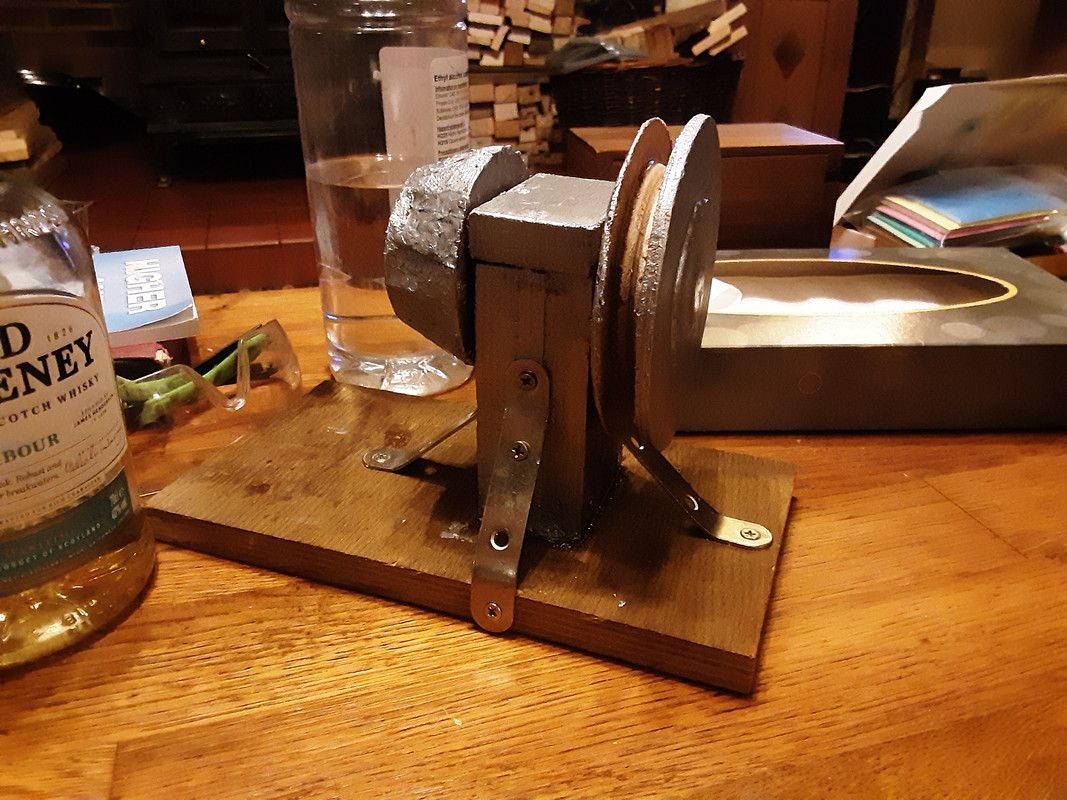
Next weekend, I will hoist the nacelle into the cradle, bolt the pulley and clutch to the table and connect the rope drive. At this point, the machine will be fully operational.
#47 Re: Science, Technology, and Astronomy » Building Solar from scratch » 2025-08-17 15:07:44
We could build solar thermal powerplants on a much simpler resource base than would be possible for PV. The problems with solar thermal are: (1) It requires active tracking of the sun; (2) It needs direct sunlight to work, diffuse light interupted by clouds isn't useful. PV will generate some power from diffuse light, solar thermal will not. (3) To generate power from solar thermal requires a heat engine. That means someone has to operate it and it will have moving parts that require maintenance. (4) Solar thermal, like PV, means having slender structures covering large areas, making both vulnerable to storm damage.
All that being said, if I had to build a solar powerplant in my home workshop, I could probably build a crude solar thermal power system using LP steam. Could I build a PV system? Very unlikely. How the hell could I produce doped polysilicon in a home foundry? If I could buy the cells or panels, I coukd do the rest. But building PV cells? That is a major industrial effort. Not possible without a lot of investment in equipment.
#48 Re: Not So Free Chat » Oil, Peak Oil, etc. » 2025-08-17 14:48:22
I have great doubts about the sustainability of PV as a bulk energy source. A lot of people are emotionally attached to it because it seems to them to be an elegant solution - harnessing the power of the sun with no moving parts. But the materials requirements are huge, as is the embodied energy needed to produce all of the equipment required. On top of this, it is a technologically difficult product to produce and relies on long supply chains for all of the material inputs and equipment. PV modules are relatively cheap at present, only because the Chinese are producing them at massive scale, using stranded coal and forced labour. How long can all of the things that make it possible hold together? There are just too many things that can go wrong with PV supply chain for it to make any sense pinning our future on it. It is extremely precarious and resource intensive. People advocate it more for emotional than practical reasons. That is about as stupid as it is possible to be when dealing with something as vital to life as energy supply. We need systems that we can sustain using limited resources that are as close to home as possible.
#49 Re: Not So Free Chat » Oil, Peak Oil, etc. » 2025-08-17 14:08:06
This is a picture of a wind powered sawmill that I visited on my holiday in Holland.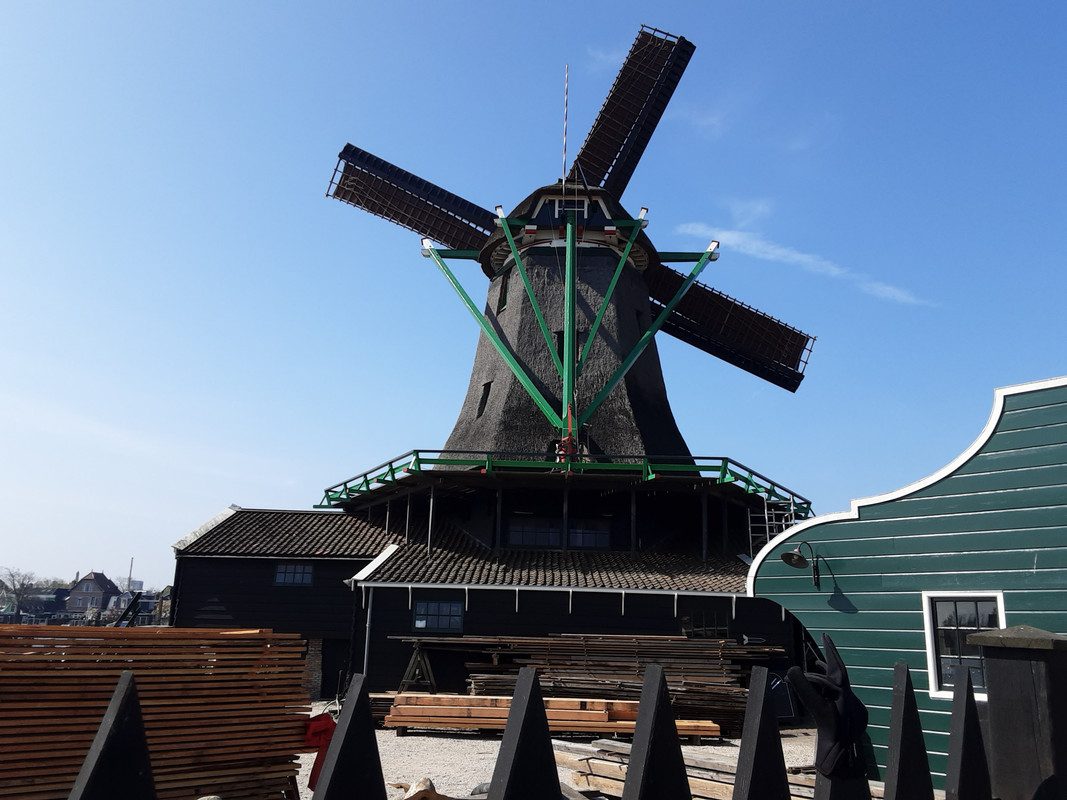
It uses no copper at all, no aluminium, no rare earths and only small amounts of iron for high stress components. It is mostly made from wood. There is no energy storage, aside from the kinetic energy stored within the sails and other rotating components. There is no backup power. The whole thing is really very simple. It is hundreds of years old and has been sawing wood for all of that time.
I think there is a lesson here in how we can sustainably use renewable energy. If we need tonnes of copper and other rare elements per MW of power, then we are clearly overcomplicating things. When you use wind and other renewables for electricity production and then add things like transmission, storage, frequency control and backup power, the costs and resource comittments rapidly become untenable. But in previous times, people relied upon renewable energy without doing anything as crazy as what we are trying to do today. They used the power at its source. They avoided unnecessary energy transitions. And they varied work rate with the weather. It wouldn't have occured to them to even try and store wind energy and it wouldn't have possible even if it had occured to them.
I think this raises serious questions and deserves serious thought. We have built a civilisation on the principle of converting chemical energy into rotary motion. How much of what we need as a society could we adapt to make use of the rotary motion provided by direct mechanical wind power?
#50 Re: Home improvements » Misc. Home Projects » 2025-08-17 13:06:42
It has been a busy weekend. I decided to modify my windmill to make it more versatile. After installing the tower, I realised that putting the tumbling pot in the nacelle was a bad idea. It means having to climb 20' up a ladder every few days to change it. Do that 100 times per year and the risk of falling off the ladder and killing myself becomes significant.
I decided to modify the design so that the rotating nacelle drives a pulley, which transfers power via a rope drive to the tumbling pot. This is mounted on a table which is attached to the tower at waist height. The pulley on the table drives a short shaft through a bearing, with the other end of the shaft driving a cone clutch (male). The tumbling pot is mounted on its own bearings. The female coupling of the cone clutch drives the tumbling pot on its bearings. The tumbling pot can be disconnected by pulling the male and female parts of the cone clutch apart.
The modification has added a lot of time to the build process. But in addition to the improved safety of having the tumbling pot close to the ground, I should be able to use the windmill to drive other tools. Once it is up and running, practically any rotating tool can be driven by the windmill by fitting it with a female cone clutch and clamping it to the table. An obvious addition would be a small wood lathe. A disc saw is another possibility, as is a grinder. I have a flexible coupling that I can use to drive a drill as well.
My intention is for the stone tumbling to function as a sort of dump load. When I need mechanical power for some other tool, the tumbling pot will be disconnected and then reconnected when the job is finished. This allows the windmill to power multiple applications, without any energy being wasted.
The power produced by the windmill depends upon windspeed, air density, swept area and efficiency. The blade diameter is 2m. Assuming efficiency of 33% (2/3rd the Betz limit), a 10mph wind would produce 58W of power. I do not know what the efficiency of the device is. A low end of 25%, would give a power 42W in a 10mph wind. A 35% efficiency would give 60W. Since I don't know what the efficiency is, I can only estimate power to be 40-60W in a 10mph wind. A mini wood lathe draws about 100W of power, which equates to a 12.6mph wind speed for my machine. A bench grinder consumes anywhere between 150 - 400W. Of course tools will still work at lower power. But work rate will be correspondingly reduced.